Photo
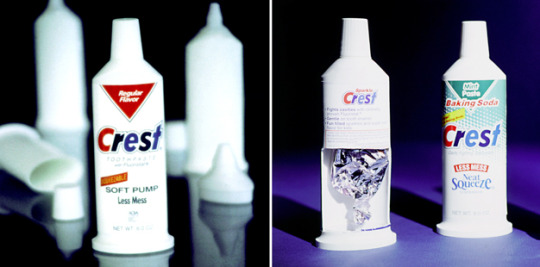
CREST NEAT SQUEEZE TUBE FOR PROCTER & GAMBLE
Stand-up toothpaste dispenser
IDEO’s work on consumer goods is best exemplified by the Neat Squeeze tube that we helped Procter & Gamble design. IDEO’s contribution included work on alternative tip designs and wall sections for this popular product, which is currently being manufactured in the tens of millions.
Project date: 1988
2 notes
·
View notes
Photo
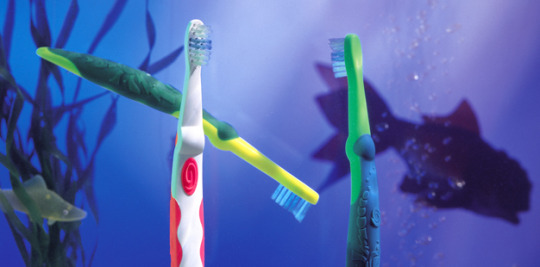
GRIPPER FOR ORAL-B
Soft-handled children's toothbrush
IDEO’s design for these Oral-B children’s toothbrushes features a combination of the organic, soft look of the Squish Grip model (ages 5-8) applied to the overall shape of a slimmer, longer adult brush, slightly reproportioned for smaller hands.
Typical Oral-B elements, like the raised ridges on the front and back of the handle, have been reinterpreted in a playful, more childlike way. This aesthetic guarantees that the Gripper is not just a shrunk version of the adult model. Overall, this design improves user comfort and control of the brushing process with its unique shape and use of material.
Project date: 1996
0 notes
Photo
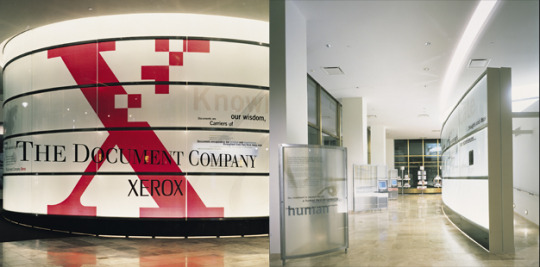
KNOWLEDGE SHARING CENTRE FOR XEROX
Retail space with interactive exhibits
The Xerox Knowledge Sharing Centre was developed by IDEO’s environments and interaction design groups to showcase Xerox products and service offerings. It marks the first time that Xerox has a showroom on the ground floor accessible to the public, and its location at Park Avenue and 47th Street situates Xerox in a highly visible environment in which the brand can be promoted.
The space had to accommodate a range of visitor types and a variety of selling styles among a diverse sales staff. Consistent customer journey scenarios were developed which would leave the visitors with an understanding of the complexity of managing documents. Interactive exhibits serve to teach the unguided visitor about the history and future of documents as well as highlighting current Xerox development efforts. Demonstration rooms support the sales process through a range of sales tools, and briefing rooms provide space for large-scale presentations. The result is a dynamic, vibrant environment that supports a consistent brand message.
Project date: 1998
0 notes
Photo

I-ZONE FOR POLAROID
Pocket instant camera
Released in 1999, Polaroid’s I-Zone pocket camera combines an understanding of kids’ photography behavior with apprpriate design to become the best-selling camera in the US, adopted by kids from nine to nineteen.
I-Zone creates small instant pictures in seconds, which kids can make with special sticky-back film to apply photos to helmets, books, backpacks, and each other. The camera is available in multiple colors, with soft rubber tread grips and clear instructions printed on the bottom.
IDEO’s human factors and industrial design team spent weeks interviewing kids from the “tween” to teen years in order to understand their likes and dislikes. By using image boards filled with advertising and recording their tastes in shoes, cameras, watches, personal stereos, and computer input devices—all popular purchases in this age group—the team was able to clearly define their preferences. Key to this work was the discovery that kids use cameras for “photo play,” an expression of creativity and a method to connect with friends.
The industrial designers then used these findings to apply an appropriate form and function and create a distinctive new addition to Polaroid’s line. The splashes of color, soft-grip edges, and compact size combine to create an easy-to-hold and easy-to-use camera, one that can be carried conveniently in a pocket and brought out quickly to capture the dynamic action in a typical kid’s life.
Project date: 1999
1 note
·
View note
Photo

Elegant insulin injection device
The HumaPen(R) Luxura™ is an insulin injector that combines several innovations into a robust yet elegant pen device that can be carried and used anywhere. Eli Lilly and Company sought to develop a new reusable insulin pen design to augment the existing line, and improve on a variety of functional characteristics of existing devices. Lilly tasked IDEO with the engineering, product and industrial design challenge to develop a design that improved:
• Dose mechanics: Enable a smooth and quiet rotation of the dose knob
• Dose setting: Enable the pen to dial backwards if you dial past the needed dose (previous reusable pens wasted insulin if the patient needed to dial back the dose);
• Injection force: Reduce the thumb pressure needed to inject and reduce the variability around that force;
• Cartridge changing: Enable the 3 milliliter glass cartridge to be more easily replaced; and,
• Plunger Reset: Enable a simpler push reset of the plunger vs the manual “re-threading”
In addition to the enhanced functional performance, Lilly asked IDEO to imbue this pen with a more “dressy,” and less “medical-looking” appearance. IDEO’s designers dressed the robust mechanical design described above in a graceful, elegant appearance and form factor, with a matte-finish painted body and chrome dose knob and clip. The high-quality image helps minimize the stigma of injecting in public, which more “clinical-looking” pens can convey. Many patients expressed to us that appearance was very important and made them less concerned about dosing in public.
The result of this design effort — the Luxura™ Pen — delivered an enhanced set of functional characteristics, with a polished look that recalls a fine writing instrument. Launched in the UK, Japan, Germany and other markets starting in 2002, it has been very well accepted.
Project date: 2005
0 notes
Photo
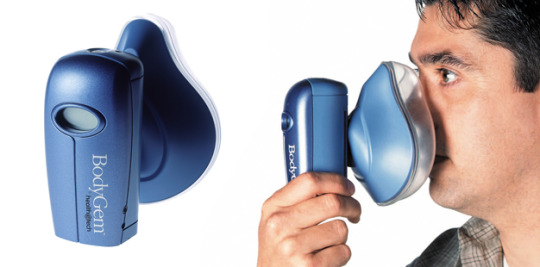
BODYGEM FOR HEALTHETECH
Handheld metabolic measurement device
Healthetech’s BodyGem is an indirect calorimeter, an innovative handheld device that measures oxygen consumption to determine the body’s metabolism while at rest and during exercise. This allows individuals monitoring their health and diet to accurately assess their caloric needs, providing better data than is possible with prediction estimates.
Measuring resting metabolic rate was previously possible only in large, expensive devices found in hospitals and research clinics; now the portable and affordable BodyGem brings this function to the individual through the use of revolutionary oxygen and flow sensor technology.
IDEO’s mechanical and electrical engineers, working closely with the sensor manufacturers, created a compact and accurate flow tube measurement system in order to precisely measure flow whether inhaling or exhaling. IDEO’s human factors experts measured a wide range of face geometries to develop both a mask and a mouthpiece, ensuring proper airflow measuring. The device performs its own internal calibration, and results are displayed immediately. The BodyGem also incorporates an array of special algorithms supporting operation in the uncontrolled environments outside of medical clinics, thus allowing this compact device to be used in homes, fitness centers, and weight-loss clinics. Additionally, after completion of regulatory approval, hospital dietitians and doctors will use the BodyGem to measure the nutritional needs of patients in clinics as well as hospitals.
Project date: 2000
0 notes
Photo

ACELA FOR AMTRAK
Interiors for high-speed train
Amtrak engaged IDEO and the New York-based branding firm OH&Co;. to propose a strategy for its new high-speed rail service between Boston and Washington, D.C. The challenge was to differentiate rail travel from airlines and automobiles in quality of service across all aspects of the experience of rail travel. IDEO identified ten steps in the passenger’s journey, from learning about Amtrak and planning a trip through to arriving at the destination and continuing on.
To understand Amtrak’s vision, IDEO’s team rode trains, toured stations, interviewed senior management, and analyzed Amtrak’s information distribution and advertising campaigns. They conducted in-depth user profiles and studied Amtrak’s customer research. This information guided the development of trainset layout and design, a set of station concepts, and a brand strategy and image platform. Through this integrated design approach, IDEO presented a complete program that aimed at rising above simply presenting a new trainset but a new vision of 21st century transportation.
Project date: 1999
0 notes
Photo
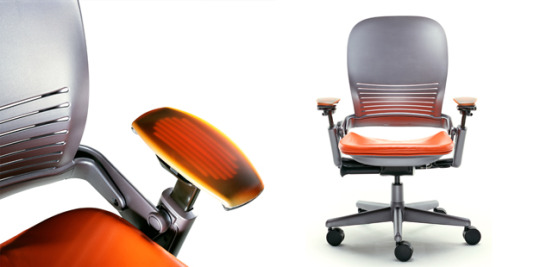
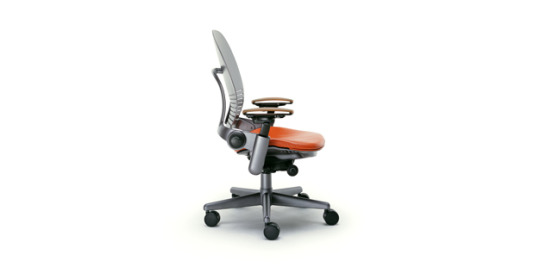
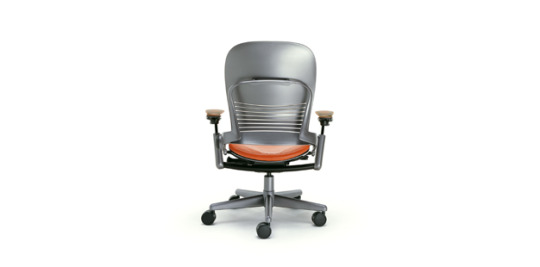
LEAP FOR STEELCASE
Adjustable office chair
More than just a new task chair, Steelcase’s Leap represents a significant new technology in back support. Four years of research—11 studies by 27 scientists at four universities—revealed critical discoveries that guided the design of the chair:
-Each spine is unique, so Leap’s Live Back mimics your unique spinal motion as you change posture.
-The spine doesn’t move as a single unit, so the upper and lower back support mechanisms are independently adjustable.
-People naturally change their sitting posture throughout the day, so Leap’s Natural Glide System © allows you to recline without changing your orientation to your work.
IDEO contributed an organic design language that reveals the chair’s elegant mechanics, as well as engineering insights that enabled the original design to be realized in a revolutionary new way. The result is a breakthrough in seating technology, protected by 30 issued and 6 pending patents (as of February 2003).
Following its debut, Leap generated record-setting pre-production orders as well as exceptional publicity for the client. In 2002, a group of research institutes found that the design increased productivity by 17.8% during a twelve-month study of 200 employees. Put to simple calculation, Leap had paid for itself within ten working days.
Project date: 1999
0 notes
Photo
Creative Confidence
IDEO founder and d.school creator at Stanford University David Kelley and his brother Tom Kelley, managing director of IDEO and the author of the bestselling The Art of Innovation, have written a powerful and compelling book on unleashing the creativity that lies within each and every one of us.
Too often, companies and individuals assume that creativity and innovation are the domain of the “creative types.” But two of the foremost experts in innovation, design, and creativity on the planet show us that each and every one of us is creative. In an incredibly entertaining and inspiring narrative that draws on countless stories from their work at IDEO and with many of the world’s top companies and design firms, David and Tom Kelley identify the principles and strategies that will allow us to tap into our creative potential in our work lives, and in our personal lives, and allow us to think outside the box in terms of how we approach and solve problems. It is a book that will help each of us be more productive and successful in our lives and in our careers.
Oct 2013
http://www.creativeconfidence.com/buy

17 notes
·
View notes
Photo
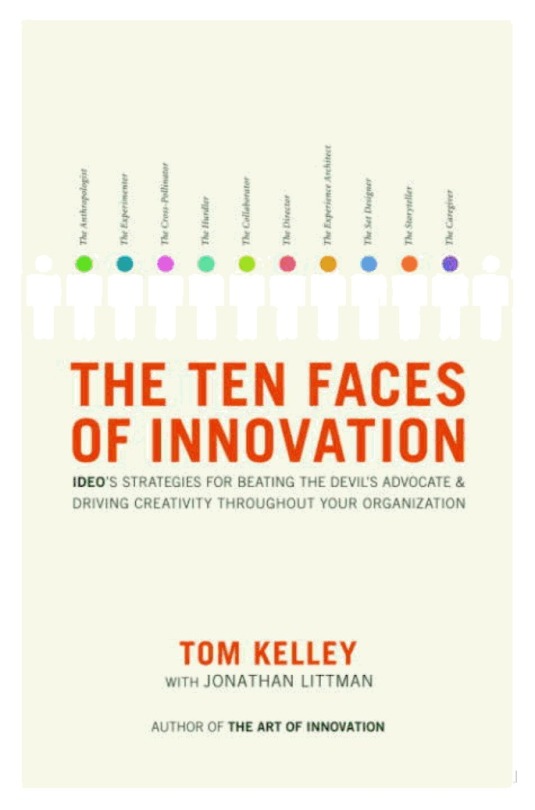
The Ten Faces of Innovation - Google Books
0 notes
Video
vimeo
RIPPLE EFFECT: ACCESS TO SAFE DRINKING WATER FOR ACUMEN FUND AND THE BILL & MELINDA GATES FOUNDATION
Seeding innovation in the water sector
Some 1.2 billion people worldwide are drinking unsafe water. Although many organizations purify water at a community scale, people spend significant time and effort to transport it — and it often becomes contaminated during the trip. From retrieval to consumption, water’s journey is complex and provides ample opportunities for improvement.
Acumen Fund and IDEO, with backing from the Bill & Melinda Gates Foundation, joined forces to tackle the issues of water transport and storage. The Ripple Effect project aims to improve access to safe drinking water for the world’s poorest and most under-served people; to stimulate innovation among local water providers; and to build the capacity for future development in the water sector.
Ripple Effect is a new model that connects organizations, provides insights and inspiration, and gives design and business support to entrepreneurs looking to develop new offerings. The project is entirely public: Acumen Fund and IDEO teams are working closely with local companies and NGOs that provide safe drinking water, and capturing learnings for others to benefit from. The first phase of the project took place in India (November 2008 to June 2009), and the second phase was in East Africa (July 2009 to March 2010).
In any region, our work starts with field research to understand the needs and desires of stakeholders in the water journey, from customers to providers. We then gather organizations to share insights and collaborate around solutions — products, services, and systems that improve water delivery and storage. This is followed by the Ripple Effect Award, an eight-week funded pilot phase during which the awardees prototype new business ideas with help from the IDEO and Acumen Fund teams.
“There is no silver bullet to the world water crisis. Addressing the crisis certainly is not simply a matter of better product design — we will need a range of options that accommodate for the myriad varying climatic, hydrological, terrestrial, and cultural dimensions of the problem,” noted Jonathan Greenblatt of Worldchanging.org. “New players like IDEO can offer highly useful lessons from the field of design that, when adapted to the water sector, could yield interesting results.”
To date, our work in India and Africa has contributed to new distribution models, automated water vending machines, and better vessels for existing businesses. These small-scale pilots provide the awardees with opportunities to learn, experiment, and innovate before expanding their operations.
Project date: 2009
0 notes
Photo

RIPPLE EFFECT: ACCESS TO SAFE DRINKING WATER FOR ACUMEN FUND AND THE BILL & MELINDA GATES FOUNDATION
Seeding innovation in the water sector
Some 1 billion city dwellers worldwide lack adequate sanitation facilities in their homes. The reasons they don’t add a bathroom vary from too-cramped living quarters to inadequate resources. Unilever, a multinational maker of consumer products, and WSUP, a nonprofit, tri-sector partnership working to improve access to safe, affordable water and sanitation, were looking for ways to overcome these barriers. They asked IDEO to help determine the best approach to developing new products and services for the urban poor. We chose Kumasi, Ghana, a city of 2.5 million people with less than 20 percent of the population having access to in-home sanitation, as our test market. In Kumasi, many people walk, sometimes long distances, to a public toilet. Others resort to “flying toilets” (plastic bags that get thrown outside after use).
Unilever, which is a household name in many corners of the world, sells health and well-being products in more than 180 countries; more than 50 percent of its business comes from emerging markets. The company was looking to develop a suitable toilet/collection service to provide a complete in-home sanitation solution. Sanitation is an area of interest because there is tremendous need and the company sees healthier, happier people as more likely to buy its other products.
IDEO conducted interviews with families in Kumasi and Accra, Ghana, and researched the global state of sanitation innovation. Based on our findings, we came up with the concept for a “high touch service toilet.” We prototyped various working toilets in Kumasi households, a process that revealed people’s true in-home sanitation needs. With user feedback, we iterated our designs and ultimately arrived at a practical, functional commode.
The general idea was for a service that rents portable toilets to families and charges a weekly or monthly fee to collect the waste. Unilever would train and distribute franchise opportunities to local operators to run the service and eventually manufacture and supply the toilets. Operators could lease-to-own the toilets, growing their own business over time.
The project, from start to finish, took just three months. Our final deliverables consisted of a research report, the basic structure of how the service would work, branding details (logo and uniforms), and a 3-D prototype of the portable toilet and waste tank. In July 2011, Unilever plans to launch a six-month pilot test in 100 Kumasi homes to further refine the business, service, and system models. There is talk of introducing the model to cities in Bangladesh and Kenya within the next two years.
IDEO publicly disclosed its insights, lessons learned, and design concepts viaTwitter and a blog (www.ghanasan.com). This allowed us to broadly share the project and process with the sanitation community globally. We also launched an innovation challenge on OpenIDEO. Here, the OpenIDEO open innovation community shared 122 inspirations and 69 concepts for new sanitation solutions that could be appropriate for an urban context.
Project date: 2011
0 notes
Video
vimeo
Our Invitation To You
Climate change touches every aspect of social and economic life, from energy resources to water and forest sustainability; from food supplies to human security. Living Climate Change offers up a divergent set of future scenarios from the IDEO community and beyond. As Tim Brown invites you to do in his video message, “Help us expand the conversation.” Visit livingclimatechange.com
0 notes
Video
vimeo
The Future of Self-Service Banking
The Future of Self-Service Banking -- from BBVA and IDEO
0 notes
Video
vimeo
c60 Redux
The c60 music player from IDEO’s Boston office. The team brought to life a concept from Martin Bone and Kara Johnson’s book, I Miss My Pencil, that brings physicality back to the experience of listening to music.
0 notes
Photo
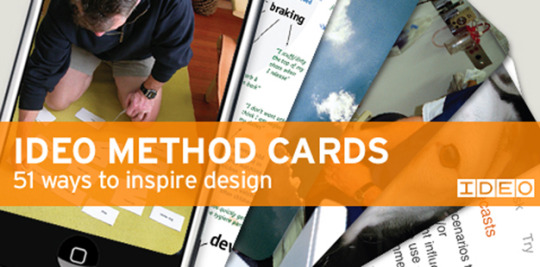
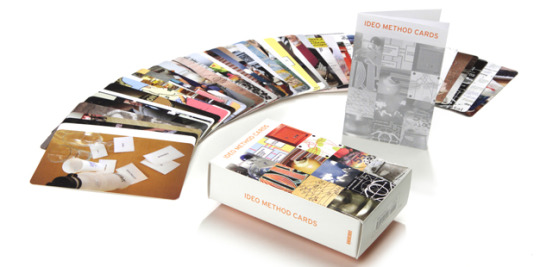
METHOD CARDS FOR IDEO
51-card deck to inspire design
IDEO Method Cards is a collection of 51 cards representing diverse ways that design teams can understand the people they are designing for. They are used to make a number of different methods accessible to all members of a design team, to explain how and when the methods are best used, and to demonstrate how they have been applied to real design projects.
IDEO’s human factors specialists conceived the deck as a design research tool for its staff and clients, to be used by researchers, designers, and engineers to evaluate and select the empathic research methods that best inform specific design initiatives. The tool can be used in various ways—sorted, browsed, searched, spread out, pinned up—as both information and inspiration to human-centered design teams and individuals at various stages to support planning and execution of design programs.
Inspired by playing cards, the cards are classified as four suits—Ask, Watch, Learn, Try—that define the types of activities involved in using each method. Each approach is illustrated by a real-life example of how the method was applied to a specific project. As new methods are developed all the time, the deck will grow and evolve over time.
In its first year, the Method Cards appeared to have unexpected relevance to groups that are not necessarily engaged in design initiatives. Clients report using the tool to explore new approaches to problem-solving, gain perspective, inspire a team, turn a corner, try new approaches, and to adapt and develop their own methods.
IDEO Method Cards are available exclusively from William Stout Architectural Books in San Francisco. Call them at 415-391-6757 or click here to purchase online.
Project date: 2002
0 notes